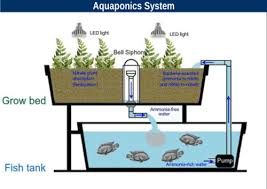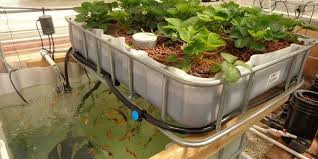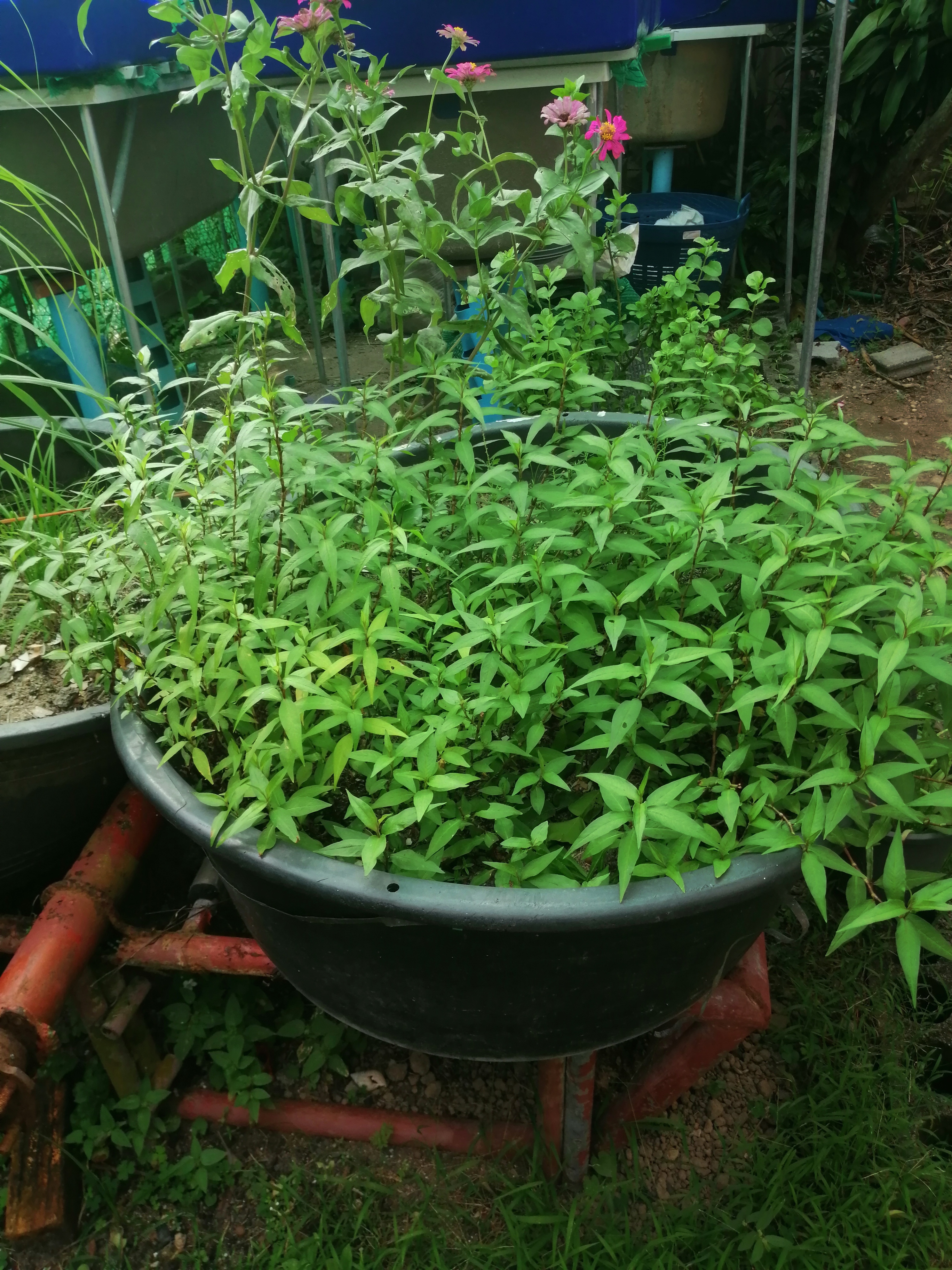Organic Thai Cooking > Blog > The best way to grow your own vegetables – Phuket Thai cooking class
The best way to grow your own vegetables – Phuket Thai cooking class
In our quest to grow as many vegetables as possible in a small area we have tried 3 different methods of crop cultivation.Which one did we find worked the best?
1.Aquaponics.
This seemed like a great method to us as it would produce both fish and vegetables.
How does it work?
As can be seen in the picture,at the bottom of the system there is a water tank filled with fish.The fish then poo in this water and in this way add nutrients,this liquid is then pumped up to where the plants grow, these plants then feed on this nutritious water and in the process also clean it,by the action of gravity the clean water goes back to the fish tank and the cycle starts again.The plants grow in small stones,not in soil,so that the water can pass through easily.
add nutrients,this liquid is then pumped up to where the plants grow, these plants then feed on this nutritious water and in the process also clean it,by the action of gravity the clean water goes back to the fish tank and the cycle starts again.The plants grow in small stones,not in soil,so that the water can pass through easily.
Advantages.
-You can have both fish and vegetables.
-If done correctly you can grow a lot in a small area.
Disadvantages.
-It is expensive to set up.
-Many things go wrong all the time.
For example the ph of the water is susceptible to changes and it’s difficult to get this right.
The fish alone do not provide enough nutrients for the plants so all sorts of other stuff needs to be added,this in turn affects the ph of the water,it is very hard to get the balance right.
Because of the large amount of water on site the air is very humid and the plants easily get fungus diseases,you need to have a good ventilation system which is expensive to install and run.
Snails and all sorts of insects love the wet environment.
2.Organic Farming.
This is the simplest and cheapest way of crop cultivation.
How does it work?
We create good organic soil, put it in containers and then add seeds.
The important thing here is to create the right type of soil and in order to do this you first have to make a compost.You do this by collecting things that will break down naturally,stuff like leafs,grass,vegetable/fruit left overs,coffee grounds,sea weed,egg shells,cow manure etc etc,mix well and you then put everything in a mound,add a little water to make it all moist (not very wet)and you turn it over every few days or so to keep it oxygenated,sometimes you add more water but not too much,only enough to make everything moist.After some time you end up with a black substance which looks like soil and this is what we call compost.You then mix this compost with normal regular soil at a ratio of 40% compost and 60% soil,using pure compost on plants will burn them,it’s too strong.
For more details about how to make compost there is a great series of videos that show you how to make compost,(and many other things), on youtube under the heading of “the weedy garden”.
Advantages.
– It is cheap and easy to do.
Disadvantages.
– Vulnerable to insects,because it’s organic no insecticides are used,there are natural home made potions to protect your plants but if you are growing things in the tropics like we are then the natural products are often not good enough to protect your plants.A net green house would be the solution but would add costs and somehow insects do still get in, also you can still have problems with things like fungus growth if there isn’t enough ventilation.
– Because it’s organic a lot more weeds grow and it can be very labour intensive.
3.A mix between Organic Farming and Aquaponics.
How does it work?
Like with aquaponics,at the bottom of the system there is a water tank,but in this case there are no fish in it.Above the water tank there is a container filled with stones and soil where the plants grow.Every hour water is pumped up for 15 minutes,this water contains special nutrients.A plastic sheet roof covers everything so that rain water can’t get in.
Advantages
– Fantastic plant growth,you can grow large amounts in a small area.
– Few problems with insects,we can grow everything at an elevated level which helps to keep the insects away.Also because our plants are so healthy the insects are not so attracted.
– Very little work to keep the system running,almost no weeding,only sometimes you need to add some water and nutrients and every 2 weeks we use a nutrient foliar spray on the plants or add seeds and that’s it.
Disadvantages
– Not very expensive but you do have to spend some money on the necessary things,once everything is installed most things will last you for a very long time,you can also use recycled products,like for example we used old bath tubs.
– It takes a while to get the system up and running,you have to be be prepared to put in the work.
So which method works the best?
For us it was definitely the mixed organic farming and aquaponics method.This way we are getting the best of both worlds.With the aquaponics part of the system we are able to deliver nutrients to the plants in the special aquaponic way but then without the complication of having fish and the associated water ph imbalances.With the organic farming part we are able to give the plants special nutrients too and the soil acts as a stabiliser to the system,also we hardly have any insect problems like you would usually have when you are growing plants the organic way,the plastic roof that keeps out the rain also makes the environment more stable.

 中文
中文